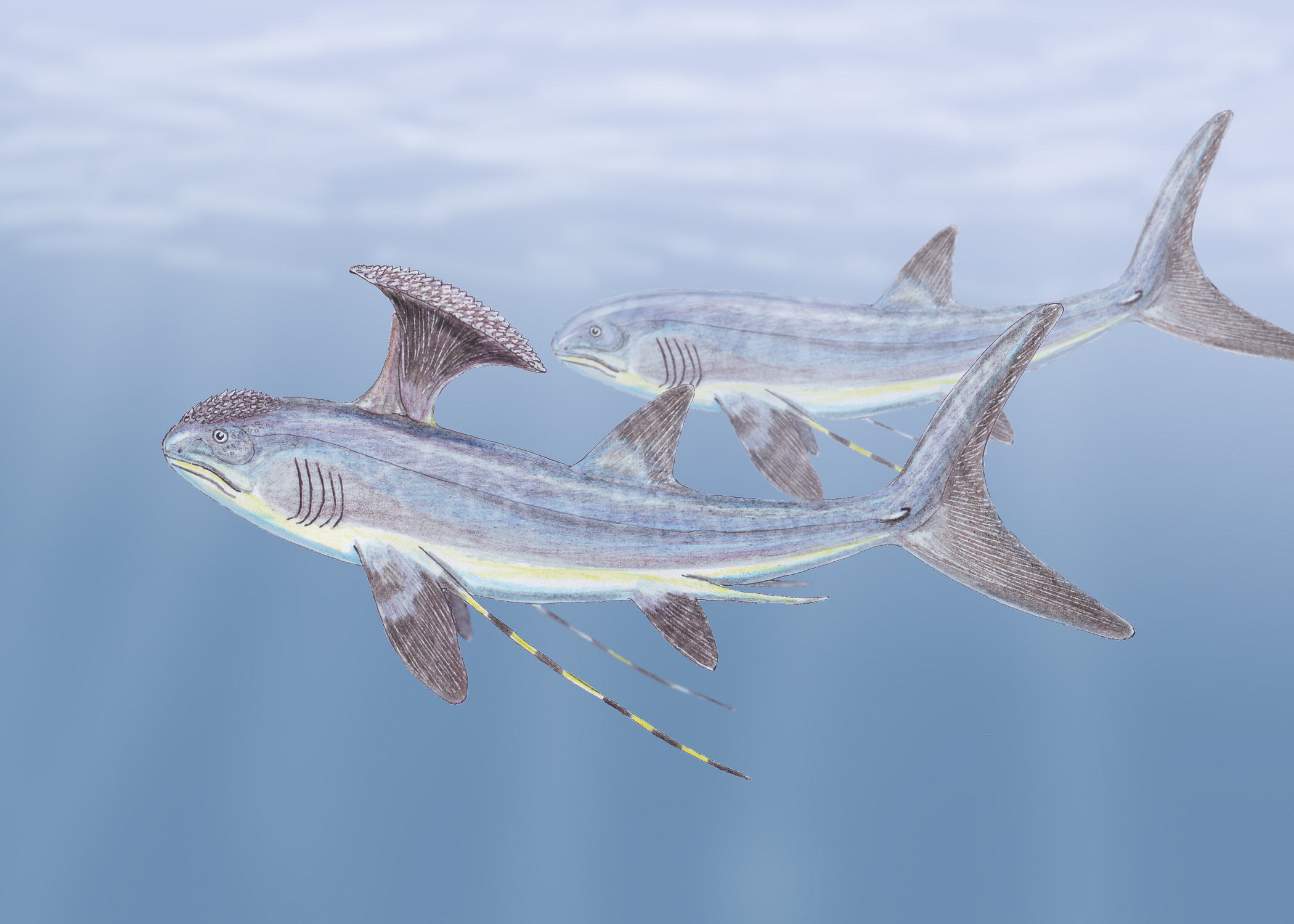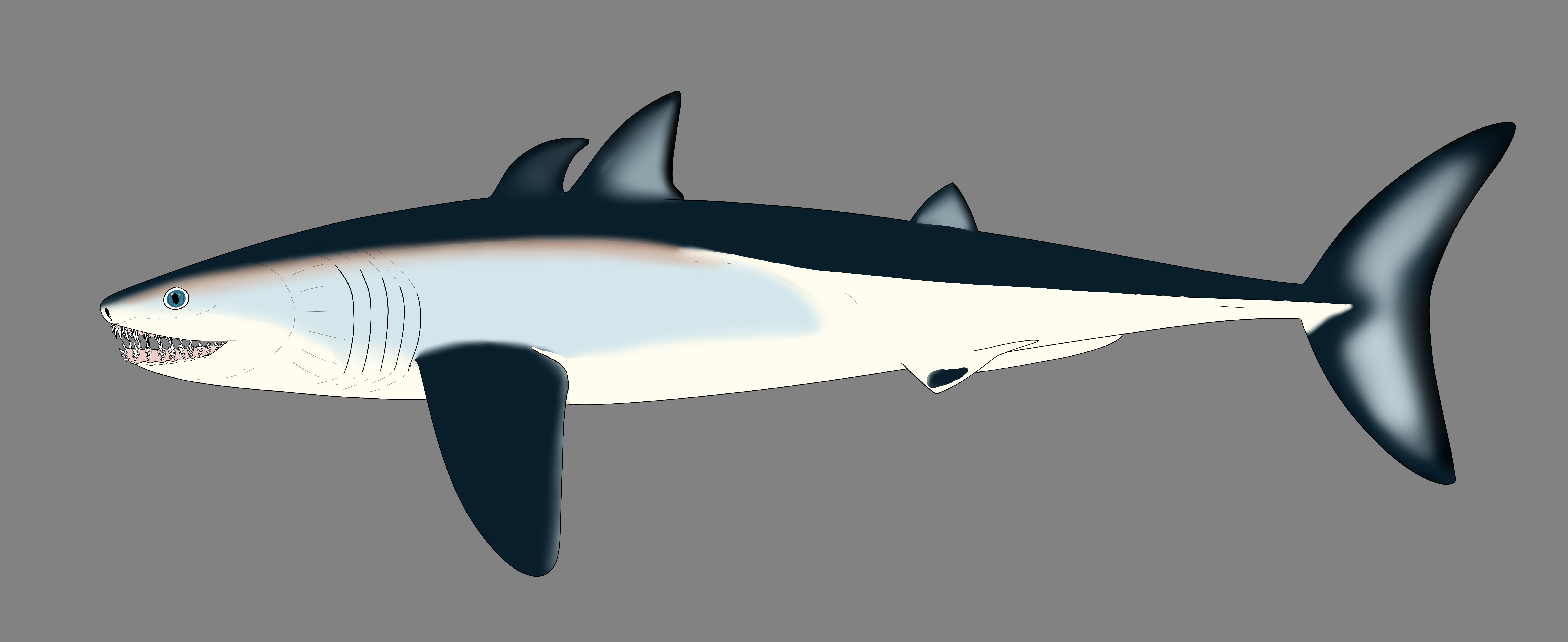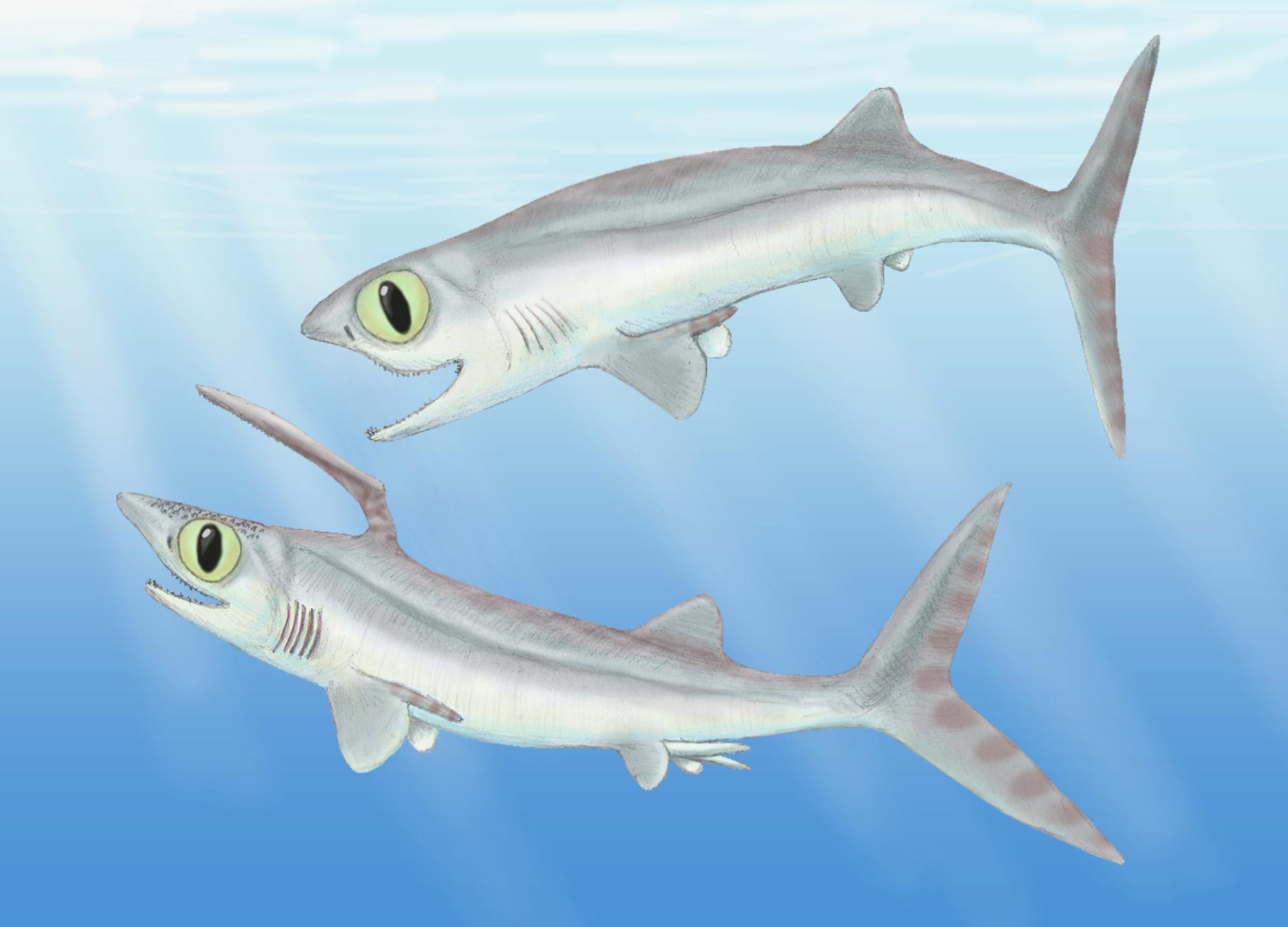|
Symmoriida
Symmoriiformes is an extinct order of holocephalians. Originally named Symmoriida by Zangerl (1981), it has subsequently been known by several other names. Lund (1986) synonymized the group with Cladodontida, while Maisey (2008) corrected the name to Symmoriiformes in order to prevent it from being mistaken for a family. The symmoriiform fossils record appear at the beginning of the Carboniferous. Most of them died out at the start of the Permian, but ''Dwykaselachus'' is known from the Artinskian-Kungurian of South Africa. Teeth described from the Valanginian of France and Austria indicate that members of the family Falcatidae might have survived until the Early Cretaceous; however, these teeth were also argued to be more likely neoselachian teeth. Fossil distribution Fossil evidence of Symmoriida have been found at Bear Gulch, Fergus County, Montana, Bethel Quarry, Pike County, Indiana, Kinshozan quarry, Alaska, Gifu Prefecture, Japan, Bashkortostan, Russian Federation an ... [...More Info...] [...Related Items...] OR: [Wikipedia] [Google] [Baidu] |
Stethacanthus Productus
''Stethacanthus'' is an extinct genus of shark-like holocephaliansCoates, M., Gess, R., Finarelli, J., Criswell, K., Tietjen, K. 2016. A symmoriiform chondrichthyan braincase and the origin of chimaeroid fishes. Nature. doi: 10.1038/nature20806 which lived from the Late Devonian to Late Carboniferous epoch, dying out around 298.9 million years ago. Fossils have been found in Asia, Europe and North America. Etymology ''Stethacanthus'' comes from the Greek στῆθος (''stēthos''), meaning "chest", and ἄκανθος (''akanthos''), meaning "spine" or "thorn". The name refers to the distinctive anvil-shaped first dorsal fin and spine displayed by mature males of the genus. Description ''Stethacanthus'' had different sizes depending on species, ''S. altonensis'' had length about , while ''S. productus'' reached . In many respects, it had a shark-like appearance. However, it is best known for its unusually shaped dorsal fin, which resembled an anvil or ironing board. Small s ... [...More Info...] [...Related Items...] OR: [Wikipedia] [Google] [Baidu] |
Stethacanthidae
Stethacanthidae is an extinct family of prehistoric holocephalians. It is estimated to have existed approximately between 380 and 300 million years ago. Members of this family are noted for their peculiar dorsal fin. Introduction The taxonomic history of the Family Stethacanthidae has been rather complicated because the findings of complete skeletons are very unusual, and as result early workers such as St. John & Worthen, and Newberry were unable to recognise the association of the spine, dentition teeth, and dermal denticles of these sharks. The genus ''Stethacanthus'' was established by Newberry (1889)NEWBERRY, J.S., 1889. The Paleozoic fishes of North America. ''United States Geological Survey Monograph'', 16, 340pp. for a series of large thin walled, cartilage-cored spines encountered in Mississippian (Carboniferous Period) rocks of the mid-continental United States. Decomposition of the internal cartilage and compression during burial resulted in distortion of the spines, ... [...More Info...] [...Related Items...] OR: [Wikipedia] [Google] [Baidu] |
Stethacanthus Altonensis
''Stethacanthus'' is an extinct genus of shark-like holocephaliansCoates, M., Gess, R., Finarelli, J., Criswell, K., Tietjen, K. 2016. A symmoriiform chondrichthyan braincase and the origin of chimaeroid fishes. Nature. doi: 10.1038/nature20806 which lived from the Late Devonian to Late Carboniferous epoch, dying out around 298.9 million years ago. Fossils have been found in Asia, Europe and North America. Etymology ''Stethacanthus'' comes from the Greek στῆθος (''stēthos''), meaning "chest", and ἄκανθος (''akanthos''), meaning "spine" or "thorn". The name refers to the distinctive anvil-shaped first dorsal fin and spine displayed by mature males of the genus. Description ''Stethacanthus'' had different sizes depending on species, ''S. altonensis'' had length about , while ''S. productus'' reached . In many respects, it had a shark-like appearance. However, it is best known for its unusually shaped dorsal fin, which resembled an anvil or ironing board. Small s ... [...More Info...] [...Related Items...] OR: [Wikipedia] [Google] [Baidu] |
Chondrichthyes
Chondrichthyes (; ) is a class that contains the cartilaginous fishes that have skeletons primarily composed of cartilage. They can be contrasted with the Osteichthyes or ''bony fishes'', which have skeletons primarily composed of bone tissue. Chondrichthyes are jawed vertebrates with paired fins, paired nares, scales, and a heart with its chambers in series. Extant chondrichthyes range in size from the 10 cm (3.9 in) finless sleeper ray to the 10 m (32 ft) whale shark. The class is divided into two subclasses: Elasmobranchii (sharks, rays, skates, and sawfish) and Holocephali ( chimaeras, sometimes called ghost sharks, which are sometimes separated into their own class). Within the infraphylum Gnathostomata, cartilaginous fishes are distinct from all other jawed vertebrates. Anatomy Skeleton The skeleton is cartilaginous. The notochord is gradually replaced by a vertebral column during development, except in Holocephali, where the notochord stays intact. In some deepwat ... [...More Info...] [...Related Items...] OR: [Wikipedia] [Google] [Baidu] |
Symmoriidae
Symmoriidae is an extinct family of holocephalians from the Devonian and Carboniferous The Carboniferous ( ) is a geologic period and system of the Paleozoic that spans 60 million years from the end of the Devonian Period million years ago ( Mya), to the beginning of the Permian Period, million years ago. The name ''Carbonifero ... periods. References {{Taxonbar, from=Q2374629 Devonian first appearances Symmoriiformes Prehistoric cartilaginous fish families ... [...More Info...] [...Related Items...] OR: [Wikipedia] [Google] [Baidu] |
Carboniferous
The Carboniferous ( ) is a geologic period and system of the Paleozoic that spans 60 million years from the end of the Devonian Period million years ago ( Mya), to the beginning of the Permian Period, million years ago. The name ''Carboniferous'' means "coal-bearing", from the Latin '' carbō'' ("coal") and '' ferō'' ("bear, carry"), and refers to the many coal beds formed globally during that time. The first of the modern 'system' names, it was coined by geologists William Conybeare and William Phillips in 1822, based on a study of the British rock succession. The Carboniferous is often treated in North America as two geological periods, the earlier Mississippian and the later Pennsylvanian. Terrestrial animal life was well established by the Carboniferous Period. Tetrapods (four limbed vertebrates), which had originated from lobe-finned fish during the preceding Devonian, became pentadactylous in and diversified during the Carboniferous, including early amphibian line ... [...More Info...] [...Related Items...] OR: [Wikipedia] [Google] [Baidu] |
Cladoselache
''Cladoselache'' is an extinct genus of shark-like chondrichthyan (cartilaginous fish) from the Late Devonian (Famennian) of North America. It was similar in body shape to modern lamnid sharks (such as mako sharks and the great white shark), but was not closely related to lamnids or to any other modern (selachian) shark. As an early chondrichthyan, it had yet to evolve traits of modern sharks such as accelerated tooth replacement, a loose jaw suspension, enameloid teeth, and possibly claspers. Some 20th century studies considered ''Cladoselache'' to be a basal (early-diverging) member of Elasmbobranchii, the fork of cartilaginous fish which leads to modern sharks and rays. More recent studies have identified distinctive traits of the chondrocranium (cartilaginous braincase), dorsal fin spines, and pectoral fin bases. These newly identified features support a close relationship to symmoriiforms, a small group of bizarre chondrichthyans such as the bristle-spined '' Stethacanthu ... [...More Info...] [...Related Items...] OR: [Wikipedia] [Google] [Baidu] |
Holocephali
Holocephali ("complete heads"), sometimes given the term Euchondrocephali, is a subclass of cartilaginous fish in the class Chondrichthyes. The earliest fossils are of teeth and come from the Devonian period. Little is known about these primitive forms, and the only surviving group in the subclass is the order Chimaeriformes. Chimaeriformes, commonly known as chimaeras, includes the rat fishes in the genus '' Chimaera'', and the elephant fishes in the genus ''Callorhinchus''. These fishes move by using sweeping movements of their large pectoral fins. They are deep sea fish with slender tails, living close to the seabed to feed on benthic invertebrates. They lack a stomach, their food moving directly into the intestine. Extinct holocephalans were much more diverse in lifestyles, including shark-like predatory forms and slow, durophagous fish. Characteristics Members of this taxon preserve today some features of elasmobranch life in Paleozoic times, though in other respects th ... [...More Info...] [...Related Items...] OR: [Wikipedia] [Google] [Baidu] |
Holocephalians
Holocephali ("complete heads"), sometimes given the term Euchondrocephali, is a subclass of cartilaginous fish in the class Chondrichthyes. The earliest fossils are of teeth and come from the Devonian period. Little is known about these primitive forms, and the only surviving group in the subclass is the order Chimaeriformes. Chimaeriformes, commonly known as chimaeras, includes the rat fishes in the genus '' Chimaera'', and the elephant fishes in the genus ''Callorhinchus''. These fishes move by using sweeping movements of their large pectoral fins. They are deep sea fish with slender tails, living close to the seabed to feed on benthic invertebrates. They lack a stomach, their food moving directly into the intestine. Extinct holocephalans were much more diverse in lifestyles, including shark-like predatory forms and slow, durophagous fish. Characteristics Members of this taxon preserve today some features of elasmobranch life in Paleozoic times, though in other respects ... [...More Info...] [...Related Items...] OR: [Wikipedia] [Google] [Baidu] |
Falcatus
''Falcatus'' is an extinct genus of falcatid chondrichthyan which lived during the early Carboniferous Period in Bear Gulch bay in what is now Montana. Description This fish was quite small, only getting to around 25–30 cm or 10-12 inches long. This is about as big as some of the smallest sharks around today, like the pygmy laternshark. Falcatus was a chondricthian known as a "cladodont-toothed stethacanthid holocephalan". The first material known from the genus were the prominent fin spines that curve anteriorly over the head of the animal. When first described in 1883 from the St. Louis Limestone, these remains were given the name ''Physonemus falcatus''. However, in 1985, fossils of a new type of condrichthyan from Montana were described that displayed a high degree of sexual dimorphism. The same spines that were previously named ''P. falcatus'' were found on one of the morphs, identified as the male due to the presence of valvae.The morphology of ''Falcatus fal ... [...More Info...] [...Related Items...] OR: [Wikipedia] [Google] [Baidu] |
Chimaera
Chimaeras are cartilaginous fish in the order Chimaeriformes , known informally as ghost sharks, rat fish, spookfish, or rabbit fish; the last three names are not to be confused with rattails, Opisthoproctidae, or Siganidae, respectively. At one time a "diverse and abundant" group (based on the fossil record), their closest living relatives are sharks and rays, though their last common ancestor with them lived nearly 400 million years ago. Today, they are largely confined to deep water. Description and habits Chimaeras live in temperate ocean floors down to deep, with few occurring at depths shallower than . Exceptions include the members of the genus ''Callorhinchus'', the rabbit fish and the spotted ratfish, which locally or periodically can be found at shallower depths. Consequently, these are also among the few species from the chimaera order kept in public aquaria. They live in all the oceans except for the Arctic and Antarctic oceans. They have elongated, soft ... [...More Info...] [...Related Items...] OR: [Wikipedia] [Google] [Baidu] |
Bony Labyrinth
The bony labyrinth (also osseous labyrinth or otic capsule) is the rigid, bony outer wall of the inner ear in the temporal bone. It consists of three parts: the vestibule, semicircular canals, and cochlea. These are cavities hollowed out of the substance of the bone, and lined by periosteum. They contain a clear fluid, the perilymph, in which the membranous labyrinth is situated. A fracture classification system in which temporal bone fractures detected by computed tomography are delineated based on disruption of the otic capsule has been found to be predictive for complications of temporal bone trauma such as facial nerve injury, sensorineural deafness and cerebrospinal fluid otorrhea. On radiographic images, the otic capsule is the densest portion of the temporal bone. In otospongiosis, a leading cause of adult-onset hearing loss, the otic capsule is exclusively affected. This area normally undergoes no remodeling in adult life and is extremely dense. With otospongiosis, the ... [...More Info...] [...Related Items...] OR: [Wikipedia] [Google] [Baidu] |






